SOTDMA Class B AIS, the “new” middle way?
 It may be a while before we see the first 5 Watt SOTDMA Class B AIS transceiver actually available for sale, but it certainly is interesting to see a prototype trumpeted in SRT’s Summer 2015 Pulse Newsletter (available here). Given SRT’s main role as an original equipment manufacturer (OEM), we may first see this “new” AIS technology — perhaps with even more features — branded as Simrad, Raymarine, True Heading, Digital Yacht, Comar, etc. (and/or marketed under SRT’s own Em-Trak label). Or maybe Furuno, AMEC, Vesper or another of the independent AIS manufacturers will be first out with SOTDMA Class B? I don’t know. More important is SOTDMA Class B as a new middle ground between the Class A AIS used on large vessels (which also works on the SOTDMA protocol) and the CSTDMA Class B technology that we’re used to…
It may be a while before we see the first 5 Watt SOTDMA Class B AIS transceiver actually available for sale, but it certainly is interesting to see a prototype trumpeted in SRT’s Summer 2015 Pulse Newsletter (available here). Given SRT’s main role as an original equipment manufacturer (OEM), we may first see this “new” AIS technology — perhaps with even more features — branded as Simrad, Raymarine, True Heading, Digital Yacht, Comar, etc. (and/or marketed under SRT’s own Em-Trak label). Or maybe Furuno, AMEC, Vesper or another of the independent AIS manufacturers will be first out with SOTDMA Class B? I don’t know. More important is SOTDMA Class B as a new middle ground between the Class A AIS used on large vessels (which also works on the SOTDMA protocol) and the CSTDMA Class B technology that we’re used to…
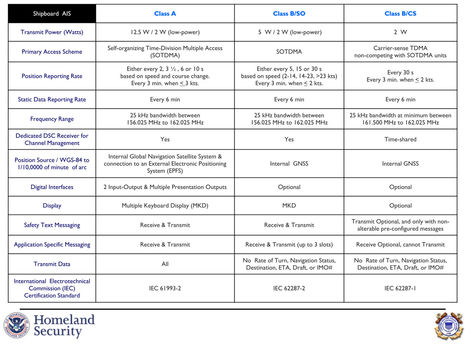 The USCG Nav Center has thankfully published an AIS Class Comparison (click above bigger or PDF download here) that neatly details the differences. Class B/SO, as they term it, cannot only transmit at more than twice the power of familiar Class B/CS, but it’s also permitted to report a vessel’s position — and other dynamic data like SOG, COG, and Heading — at higher rates, particularly when the vessel goes fast. While both forms of Class B omit some of Class A’s static vessel data like Rate-of-Turn and Destination, SOTMA Class B can apparently do more with Safety and Application Specific Messaging (i.e. the growing use of AIS for weather, lock, etc. info). Meanwhile, Class B/SO devices will only need an internal GPS/GNSS like Class B/CS but they will have a Minimal Keyboard Display (MKD) like Class A.
The USCG Nav Center has thankfully published an AIS Class Comparison (click above bigger or PDF download here) that neatly details the differences. Class B/SO, as they term it, cannot only transmit at more than twice the power of familiar Class B/CS, but it’s also permitted to report a vessel’s position — and other dynamic data like SOG, COG, and Heading — at higher rates, particularly when the vessel goes fast. While both forms of Class B omit some of Class A’s static vessel data like Rate-of-Turn and Destination, SOTMA Class B can apparently do more with Safety and Application Specific Messaging (i.e. the growing use of AIS for weather, lock, etc. info). Meanwhile, Class B/SO devices will only need an internal GPS/GNSS like Class B/CS but they will have a Minimal Keyboard Display (MKD) like Class A.
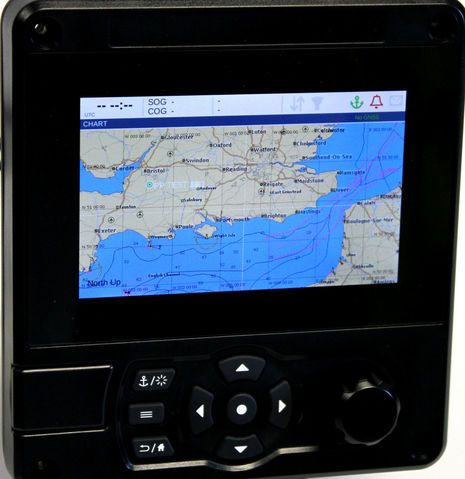 It sounds, however, like SRT is going well beyond a classic Class A MKD when they claim that the “world’s first fully certified SOTDMA 5W Class B…will be a fully integrated, ruggedized IP67 waterproof transceiver with full high resolution ENC chart display functionality and wifi connectivity.” The device also includes ABSEA (Advanced Class B Satellite Enabled AIS), a transparent feature that SRT developed with exactEarth so that even ABSEA-enabled Class B/CS transmissions can be reliably tracked by satellites (like the 72 Iridium Next low-orbiting birds that will start going up in October). The eventual retail pricing for this transceiver/display is not mentioned but Class B/SO seems likely to sit between A and B/CS in this regard, too, and is thus likely to be a “new option for commercial boat owners and larger leisure boats” as SRT puts it.
It sounds, however, like SRT is going well beyond a classic Class A MKD when they claim that the “world’s first fully certified SOTDMA 5W Class B…will be a fully integrated, ruggedized IP67 waterproof transceiver with full high resolution ENC chart display functionality and wifi connectivity.” The device also includes ABSEA (Advanced Class B Satellite Enabled AIS), a transparent feature that SRT developed with exactEarth so that even ABSEA-enabled Class B/CS transmissions can be reliably tracked by satellites (like the 72 Iridium Next low-orbiting birds that will start going up in October). The eventual retail pricing for this transceiver/display is not mentioned but Class B/SO seems likely to sit between A and B/CS in this regard, too, and is thus likely to be a “new option for commercial boat owners and larger leisure boats” as SRT puts it.
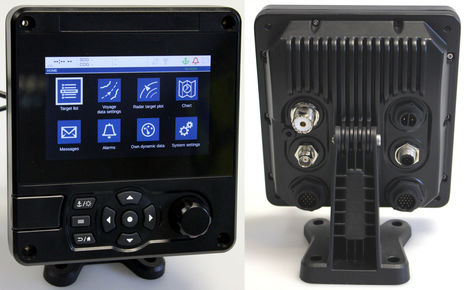 Adding to what SRT published in their newsletter, CEO Simon Tucker wrote that, “Of course the clever bit is the SDR AIS transceiver module inside. This uses our high fidelity core AIS transceiver technology so there is zero error message processing (you do actually see everything) and an SDR core which allows it to be configured in software to operate in multiple AIS modes — including as a 5W SOTDMA Class B per the relevant ITU and IEC specs…The product format itself is our new fully waterproof integrated AIS display platform. Certified IPx7, full charting capability (C-MAP) and wireless connectivity plus all the usual commercial and leisure features such as anchor alerts, etc. and a host of new innovative features.” Sound interesting?
Adding to what SRT published in their newsletter, CEO Simon Tucker wrote that, “Of course the clever bit is the SDR AIS transceiver module inside. This uses our high fidelity core AIS transceiver technology so there is zero error message processing (you do actually see everything) and an SDR core which allows it to be configured in software to operate in multiple AIS modes — including as a 5W SOTDMA Class B per the relevant ITU and IEC specs…The product format itself is our new fully waterproof integrated AIS display platform. Certified IPx7, full charting capability (C-MAP) and wireless connectivity plus all the usual commercial and leisure features such as anchor alerts, etc. and a host of new innovative features.” Sound interesting?
Correction 1/6/2020: This NavCen table was flawed. Class B/SO has the same 30-second transmit rate as B/CS up to 14 knots of vessel speed.
Now let’s look deeper at the SOTDMA Class B specification. The Coast Guard’s AIS Class comparison also illustrates what the different position reporting rates mean at various vessel speeds. A Class A ship going 14 knots transmits every 72 meters / 236 feet (or 43m / 141ft if it’s also turning), but a Class B/CS boat also at 14 knots will move 216 meters or 708 feet between its 30 second dynamic data transmissions, which could be a problem in tight, limited visibility conditions. A new Class B/SO would have transmitted twice at that same 14 knots and it gets even better at 24 knots and above when B/SO transmits at 5 second intervals while B/CS stays at its pokey 30 second rate. But does all this make a real difference in practice?
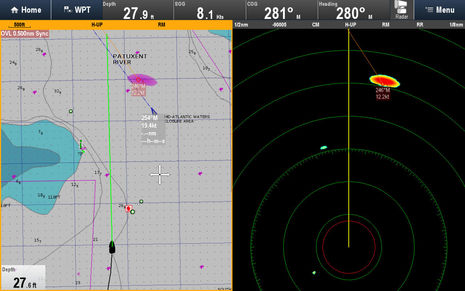 I say yes, though the slow update rate of current Class B transponders has not turned out to be as big an issue as some thought it would be before the hardware finally became available. It does take some getting used to, however. The AIS and radar targets on the Raymarine gS12 screen above are the same boat, and seeing them separated like that is a common occurrence. But then again, I managed to grab the screen close to the end of the fast yacht’s 30 second transmission gap as it blew by Gizmo on Chesapeake Bay last month, and moments later a fresh transmission jumped the AIS target to where the radar was. It’s not ideal, but you get used to it, and most boats tend to move in straight lines.
I say yes, though the slow update rate of current Class B transponders has not turned out to be as big an issue as some thought it would be before the hardware finally became available. It does take some getting used to, however. The AIS and radar targets on the Raymarine gS12 screen above are the same boat, and seeing them separated like that is a common occurrence. But then again, I managed to grab the screen close to the end of the fast yacht’s 30 second transmission gap as it blew by Gizmo on Chesapeake Bay last month, and moments later a fresh transmission jumped the AIS target to where the radar was. It’s not ideal, but you get used to it, and most boats tend to move in straight lines.
Incidentally, I’m confident that the target on that screen was doing 19+ knots, not the 12.2kt seen from the much more difficult MARPA calculation (and given the similar headings, that particular MARPA calculation is better than most I see). Target data accuracy is one beauty of AIS, and a higher update rate is one good reason why faster boats especially may adopt Class B/SO transceivers.
But how the heck did we end up with two Class B AIS standards anyway? Some interesting technical and regulatory history seems behind the story, which I’d like to know more about for a future entry. As I understand it now, SOTDMA Class B was originally intended as the Class B protocol — which is why I’ve been writing it “new” — but worries about patent licensing led the standard makers to come up with the CSTDMA scheme instead. Specifically, while inventor Anders Håkan Lans held a patent on the remarkable Self-Organized Time Division Multiple Access (SOTDMA) technique that allows AIS transceivers to work so well — able to share 2,250 data slots per minute over each of the two VHF frequencies without data collisions or central control — he agreed to forego licensing when it was used for Class A AIS. But later, when the IEC was working on the specifics of Class B hardware, Håkan Lans apparently started talking about collecting a fee and the technician/regulators scrambled for an alternate transmission technique so that Class B could be affordable. So I’ve heard.
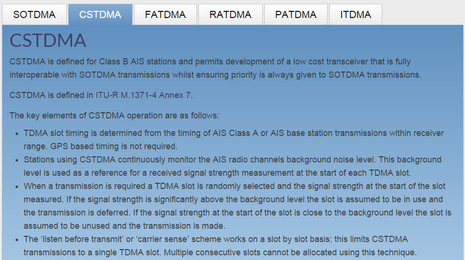 In fact, Carrier Sense TDMA works fine in my experience, and thanks in part to SRT and also to competition unrestrained by licensing, you can buy a decent CSTDMA Class B transponder for 5-600 dollars. But the change from SO to CS Class B did purportedly delay the hardware introduction and caused other issues, especially because the AIS message structure had to be changed a bit to work with CS. That’s why early users of Class B often found that Class A users could not see their boat name and other static data (but could see their boat as target). Such issues sometimes inflated by naysayers or ignorant “authorities” used to drive me nuts. And after all that settled, the same Class B/CS static data message delay plagued the NMEA 0183 to 2000 AIS translations, and thus we got the Shame Sheet! And, finally, I believe that SOTDMA Class B is becoming available now because a U.S. patent reexamination cancelled all of Håkan Lans’s claims in 2010.
In fact, Carrier Sense TDMA works fine in my experience, and thanks in part to SRT and also to competition unrestrained by licensing, you can buy a decent CSTDMA Class B transponder for 5-600 dollars. But the change from SO to CS Class B did purportedly delay the hardware introduction and caused other issues, especially because the AIS message structure had to be changed a bit to work with CS. That’s why early users of Class B often found that Class A users could not see their boat name and other static data (but could see their boat as target). Such issues sometimes inflated by naysayers or ignorant “authorities” used to drive me nuts. And after all that settled, the same Class B/CS static data message delay plagued the NMEA 0183 to 2000 AIS translations, and thus we got the Shame Sheet! And, finally, I believe that SOTDMA Class B is becoming available now because a U.S. patent reexamination cancelled all of Håkan Lans’s claims in 2010.
All of which makes me wonder how it’s possible that there was a patent on CSTDMA all along, which is now causing some friction in the industry and could possibly increase Class B/CS prices. I hope to write up the story soon, and SRT is again a major character, though readers will have to decide on hero, villain, or neither. In the meantime, I’d appreciate recollections of the Class B/CS standards making process as entry comments or direct to me (anonymity guaranteed if desired). And check out SRT’s useful AllAboutAIS.com to better understand the bouquet of TDMA protocols illustrated below and the main SRT site to see the amazing ways they’re evolving.


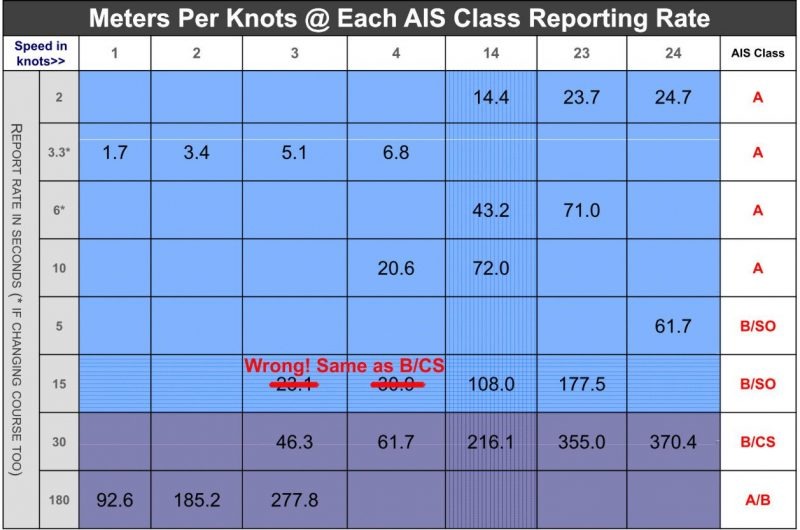
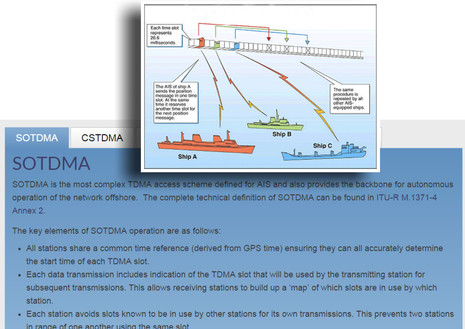
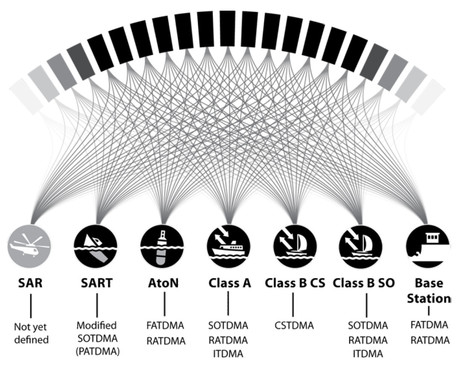

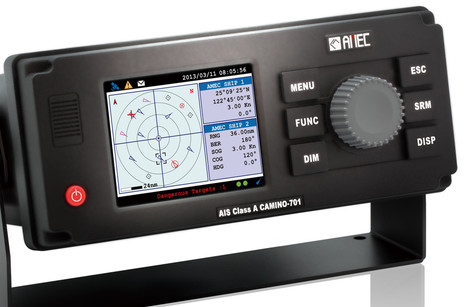

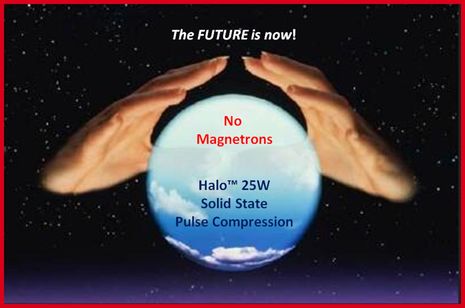







A big improvement! 30 seconds at 25-30knots, which is easily doable in a outboard powerboat makes for scary math of how apart reporting points are.
Yes, the math gets easy at 30 knots. Then a boat is moving one nautical mile every 2 minutes, or 1/4 mile every 30 seconds. So when you plot such a boat as a Class B AIS target there is a moment every half minute when its actual position is probably but not necessarily 1/4 mile ahead of its plotted position. But then the plotted position moves like a jumping bean 😉
Scary math = meaning 1/4 mile between reports is inadequate 🙂
I assume that NMEA2000 will be integrated into these new SRT devices. It is far easier for to identify and see AIS targets on my smaller 9″ screen than it is to see radar returns. Both are excellent tools, radar catches non AIS broadcasters…
I just like AIS and wish it was mandatory on all vessels.
Glad to see this coming.
A brief observation about the 30 kn speedsters. Its basically too late to react to a 30 kn boat within a 1/4 mile unless one also has a 30 kn speedster. One can hope the approaching vessel is aware of one’s proximity. Better yet, one would hope all parties have taken the appropriate action long before.
So to me there is nothing scary about the “limitation” of the CSTDMA Class B AIS reporting capabilities.
Increased transmission power output to me is a very welcome improvement. Although I’ve installed my Class B AIS with very high quality co-axial cable, and a very good antenna with an overall very good system SWR, I’m still disappointed with the range at which most other Class B AIS installations can pick me up at….and that I can observe them. I wish I had kept a written log to document this better than the ad-hoc observations I now recall.
Commercial Class A units pick me up well beyond the horizon.
I’m guessing this is due to low power, the use of smaller antennas, and in some cases, less that good installations.
With increased range, parties on a close approach with each other will have increased time to take appropriate action.
I will close with a comment I should probably resist, but here goes….even with the increased AIS capability of SOTDMA Class B AIS units, the reason I would like to see other Class B units further out, is so I can better avoid those who might not know what appropriate action might be….ie the 30 kn speedster approaching a narrow channel.
As I noted before, “only the paranoid survive”
Cheers
Don
Thanks, Don, but I’ve been hearing from the experts that power has little to do with AIS range. Last winter I heard that from Jeff Robbins at Vesper and also from SRT’s Simon Tucker, who wrote:
“The range of AIS has VERY little to do with transmit power. The physics of radio apply to all VHF systems and as you know AIS is ultimately a VHF radio communications system. The baseline reliable and repeatable range of an AIS transmission is the line of sight between the receiving and transmitting antenna – irrespective of transmit power. Antennas are configured to radiate transmissions horizontally and they continue in that general direction right on out into space – and carry on going! The height of the antennas are the fundamental determining factor of range. In reality you will see variances from time to time, due to weather conditions and ducting which can see transmissions ‘carried’ hundreds of miles terrestrially. But the range is as a matter of fact line of sight between two antennas. For example in the Galapagos where we have provided a complete fisheries monitoring system, our Identifier Class B with a 2W transmit power was tracked up to 180nm – the same as a coast guard boat fitted with a Class A. This was due to the coast station being located on a 900meter hill.”
If you read about the ABSEA technology mentioned in the entry, you’ll learn that satellites “see” AIS on the horizon, not directly above, and the problem ABSEA solves is not low power but TDMA slot collisions.
I´ve just listened to a swedish radio ducumentary about the stunning innovations from Håkan Lans and the problems with his patent rights that just are nothing but sad.. As he says: Nobody fights over the worthless things – he has been in war over patent rights for decades but never intended to do anything else than finance further inventing. SOTDMA was just too good for some of us? Ben – please get this story right and neutral, his invention threatened some big guys with radar interests.
Keep up the good work!
Regards / Martin
Dear Ben,
I have great respect for the people at Vespers. Yes, the radio wave goes on forever, yet the further one is away from the source the fainter the signal. The cross section goes as 1/R^2 in a vacuum and is a very little bit worse in air. So, given a cutoff sensitivity of the receiver above background, more power helps. The corollary to this is that the bigger your antenna is, the more sensitive you will be relative to other antennas. Think about distributed astronomical radio telescopes.
I state the above because I calculated the line of sight distance that the antenna in the Galapagos can “see” and its far far less than the 180 NM mentioned no matter what reasonable AIS transmitting antenna height you assume. Think back on which landfall you made being able to see the peaks from 180 nm out…..I can’t remember seeing one 30 nm miles out even when they were well over 1000m high. So although line of sight transmission is the the primary VHF mode, ultimately think only of this is an over simplification.
Regarding 2W power. What I do know is that shore based systems have heightened sensitivity using at a minimum, very tall antennas and signal amplifiers. Good stations have signal processors to filter out more of the noise. If one sat in the Galapagos receiving station and sampled the transmission for extended time, the S/N ratio can be improved further.
Returning to transmit power, think of the USGC. They broadcast with power well above the 25W FCC allowed power for boaters to be sure they are above the analog sensitivity of the distance receiver.
A last observation: why on earth would Class A units broadcast at 12.5W if 2W were sufficient.
have I gone off the track totally in my logic?
Cheers
Don
Pity they didn’t start with a cheaper black box. When they do I’ll probably get one.
As for the distance from shore to ship: I run a landlocked AIS receiving station for MarineTraffic and Vesselfinder. Built it when I got the class B AIS for my boat. Although I receive ships in a 25nM+ radius I usually can’t see my boat mored in the marina at less than 10nM away.
Apart from antenna height, the atmosphere plays tricks with the distance as well, have a look at http://www.marinetraffic.com/nl/ais/details/stations/1753/ to see the statistics for my station. This made the 2m amateurband (144-146Mhz) so much fun to work on, I made CW, SSB and FM contacts all over Europe during the “right conditions”.
w fr greetings, Leo
Thanks, Leo, but it looks from the USCG table that IEC 62287-2 requires a SOTDMA Class B to have an MKD. So there won’t be a black box version, though the display doesn’t have to be hi res color.
On another subject, congratulations and thank you for your volunteer Marine Traffic AIS listening station with 99.3% up-time over the last 2,154 hours! I’m curious how you use the Netcom 111 in your system. Were you able to make it push AIS data to MT without a computer being involved? Please answer on this thread:
https://panbo.com/archives/2012/05/aishub_how_you_too_can_put_ais_targets_online.html
In the table, Class B/SO reporting rate looks backward. should be based on speed (>23, 14-23, 2-14), yes?
Yes, Dan, I’m sure that position reporting gets more frequent as vessel speed increases, just like Class A. So I agree that the Class Comparison table would be clearer if it read “Either every 5, 15 or 30 s based on speed (>23, 14-23, 2-14).
But now I notice that the Meters Per Knots table shows B/SO reporting at 15 second intervals for 3, 4, 14, and 23 knots, which doesn’t seem to equate.
This USCG document is the best source I’ve found, however. Maybe someone with a copy of IEC 62287-2 can clarify?
AIS doesn’t always help to prevent collisions, but sometimes it provides good documentation:
http://maritime-executive.com/article/container-ship-and-lpg-tanker-collide
Thanks to Chris at ACR for the link.
The USCG AIS Class comparison document seems to flawed or unclear on several points. Here’s clarification courtesy of SRT:
* At higher speeds there are two Class B/SO position reporting rates, Normal and Increased Reporting Interval. The latter is used “when the network is busy (>50% used) – i.e. when there are a lot of vessels in an area, Class B SOTDMA transmits less often.”
The Class B “SO” AIS Normal and Increased Interval rates are the same 3 min at 23kn may transmit at 5s or 15s.
* “An SO Class B is not required to have a display. As with CS it needs to have some LED indicators. However IF it does have an integrated display then there are certain requirements of that display. As usual with SRT our solutions starts with a small module/ engine and then progresses with a range of standard and custom OEM products solutions – they will include black box transceivers as well as ones with displays.”
I keep coming back to watch if anyone will post the answer, to the questions above as to if 2w is enough to reach horizon, is 5w in the spec for B/SO, and 12.5w for A?
Ask and ye shall receive, every once in a while.
From SRT, not me:
“The first thing to say is that it is impossible to take a single practical experiment as a defacto statement of fact. The reason for that is that range is effected by multiple variables some of which I list below.
– The primary determining factor of range is the height of the receiving and transmitting antennas and thus the line of sight distance between them. In theory for a short data burst communication technology like AIS, transmit power is almost irrelevant – yes the strength of the signal will weaken over distance, but it really is irrelevant subject to the effect of other issues, where power can become a benefit.
– The quality of the connectors, cabling and antenna will effect the quality of the transmission – the fact that the transceiver has a 2W transmitter or 5W transmitter does not necessarily translate into 2W or 5W radiated transmit power at the point of transmit exit at the antenna.
– The ‘cleanliness’ of the transmission can effect how much adjacent channel (ACP) interference there is whilst the message is being transmitted in the VDL. As with most data burst technologies, the ‘transmit mask’ required by the specification is very tight. However this is probably tested once in a lab for type approval. The better quality the transmitter the better every transmission and thus less interference there is.
– There is some minor effect of gravity on the transmissions such that they appear to curve around the earth, but again this is very minimal.
– Many places in the world have a high level of ambient noise and due to poor operational ACP control and this causes interference which can result in reduced range.
– Weather conditions and things such as ducting can have a major effect on range.
Essentially, in an ideal world, power is not relevant to range. The biggest effect is antenna height, followed by quality and setup of equipment, followed by multiple external factors. The reason voice based systems often have higher power is that they require continuous voice streaming and not simply data bursts which can more easily accommodate variances. Sorry its not the simple reply every would want. But in todays age its easy for us all to forget that radio communications remains one part science and one part art.
We have 25 years experience of radio communications development, from mobile phones, professional radios, AIS and satellite transceivers. In AIS we have seen hundreds of different scenarios and environments and witnessed a many range outcomes. From over 180 miles in the Galapagos with a 2W transceiver, to 10 miles with a Class A in a busy EU port on a given day and then the next further.”
Radio distance calculations are based on transmitter power, antenna gain, atmospheric conditions and receiver sensitivity. Many factors can cause reduced range. Vessels rolling in a seaway will have periodic reduced antenna gain due to the main antenna pattern lobe not being parallel to the water line. Rain and other precipitation will attenuate the signal. Radio and cabling degradation over time will increase losses. Large vessels with higher antenna heights will have a line-of-sight further than most recreational vessels requiring higher power etc. Most likely the higher power rating is required for a safe design margin. The difference between 2W and 5W is only about 4 dB and another 4 dB to get from 5W to 12.5W.
Contrary to the table, IEC 62287-2 does not require an MKD.
A display is optional and where provided need only display safety related messages, SART messages, and alarm conditions.
Class B ‘SO’ Reporting Intervals (IEC 62287-1 Ed. 1.0):
* SOG 23kn, RI = 5s
The last two intervals are doubled for severely congested channels.
– “There is some minor effect of gravity on the transmissions such that they appear to curve around the earth, but again this is very minimal.”
Really?
Even a massive body like our sun only bends radio waves by 1.75 arc seconds.
I always thought that the bending of radio waves over the horizon was caused by the change in the refractive index of air as you go higher. Decreasing air pressure and air temperature with increasing height. The effect is to make it seem like the earth is flatter than it really is. For the standard atmospheric model at mid latitudes, radio planners assume that the earths radius is 4/3 times its actual radius when calculating the horizon distance.
A good explanation of this and various anomalous propagation modes here:
http://www.mike-willis.com/Tutorial/PF6.htm
Derek
I have been casually investigating “Blue Force” AIS. I know it is in use locally (at work!) but I don’t know about much about the encryption algorithm or the method of distributing the decoding key.
In the pure pursuit of knowledge, I have been searching for info and stumbled across this Turkish product
http://www.idc-defence.com/index.php?option=com_content&view=article&id=65&Itemid=71&lang=en
Key info jumped out at me;
Optional Modules
Spoofing Module Allows you to spoof your position; transmit falsified OwnShip position based on a route. You create a a route and have “ghost ship” follow (using a false MMSI).
Anti-Spoofing Module/Behavoural Analysis Provides Sentinel with the ability to detect intentional and unintentional errors in a target’s transmitted AIS data.
Anti-Spoofing Module/Position Determination Uses signal propagation analysis enabling Sentinel to detect intentional spoofs of position for manually selected targets.
Holy cow! I can only assume and expect that this type of capability is available to USA users of Blue Force. I have only seen the L3 Protector AIS system, but I have not seen a manual yet. I have also asked questions of the Furuno reps about the TZT 4.x upgrade that somehow handles Blue Force tracking, although not through a Furuno FA-150. The Furuno takes the BF AIS from the L3 transponder.
This is following on a new product data sheet that was left on our lunch table at work. A backpack/portable/mobile version of the Harris corporation “Stingray II”
I am starting to think about wearing a tinfoil hat.
“From over 180 miles in the Galapagos with a 2W transceiver,”
As an FYI, this is almost certainly because of the network of AIS repeaters set up on the Galapagos Islands, and is not a real station to station range. As we approached the Galapagos we were very surprised to start seeing vessels at 60 miles.
We’re cruising the sea of Cortez with a vesper 850 watchmate, and regularly receive class a AIS signals at over 100 nm, with the record so far being 218 nm. Our antenna height is only 12′ or so. We do see many class b AIS that don’t show up until we’re within a few miles, 15-20 say, which we put down to poor antennas. As with all signals, propagation and reception varies with time of day, with morning and evening best.
The 15-20 nM range for a class B unit with it’s 2W output is a very reasonable line-of-sight distance i.m.h.o, the 200+ nM range is caused by signal ‘ducting’, an occasional pathway created by thermal inversion.
I now have 3 AIS shore receiving stations operating and their statistical data almost reads as a weather forecast: As soon as the receiving areas start to expand I know good wheater is not far off 😉
This first SOTDMA Class B AIS is coming to market as the Em-Trak B400…
https://em-trak.com/#1529
…and also as the Si-Tex SAS 600:
http://si-tex.com/item/sas-600hybridclassbais
AMEC (Alltek Marine) released the B600 and B600W Class B AIS transponder with 5W transmit and SOTDMA.
Wrote a bit about it at https://sailbits.com/amec-widelink-sotdma-ais/
So far, so good, but still need some more testing on the water in busy times.
Ben, didn’t you mention in one of your posts that you have an em-trak B400 SOTDMA Class B on test at the moment. How’s it getting on? Anything to report? Is the integrated display any good?
Hi, Rich. Yes, I have been testing the Em-Trak B400 — which is the SRT SOTDMA Class B discussed in this entry — for quite a while, including most of the trip from Maine to North Carolina. Frankly, it’s hard to perceive the performance difference from a “slow” boat like Gizmo, even using Marine Traffic as possible and occasionally asking other boats what they are seeing.
That said, my rough impression is that the 5W transmit does not make nearly as much difference in range from 2W as the 250% difference suggests. I do think that the increased position reporting rate is very valuable, but it doesn’t kick in until 14 knots, and then even more so over 23kn.
The B400’s integrated display is impressively built and has tons of I/O capabilities, though I’d grade it B on the intuitive interface scale, and I don’t see a lot of value to high detail C-Map charts on this small a screen. The base map is usually good enough.
What’s perhaps most interesting, I think, is the pro level of detail about AIS targets of all sorts, something I mentioned in a recent discussion about AIS AtoNs:
https://panbo.com/archives/2017/11/ais_issues_garmin_navico_mcmurdo_amec_and_srt.html
I plan a thorough review pretty soon, and I also have an Amec B600W SOTDMA to test, but I still think that fast yachts should certainly consider B/SO over B/CS and I’m not sure that there other AIS displays that can show some of the details the Em-Trak B400.
Thanks for the response, Ben. I look forward to your review. Would be good to see a comparison of the B400 and B600W – I believe the B400 has WiFi as standard.
On transmit power, I think people don’t realize that this has little to do with range. A 2W (33dBm) transmission can travel over 1000 miles through air before it is attenuated below the signal level of -107dBm used for the AIS receive sensitivity specification (and most receivers do better than this). Obviously, this assumes ideal circumstances but even without those the signal can travel well beyond the true limiting factor – line of sight. And the line of sight distance is determined by the heights of the transmitting and receiving antennas. Even if these are both at 50 feet the range is just 20 miles, no problem for a 2W transmission!
So the reason why you see Class A transmission from further away than any Class B signals is not the higher power but the fact the Class A will be on a bigger ship with a much higher antenna!
However, the higher reporting rate for speedier vessels will be useful (and safer). Other than that it will be interesting to see what advantages the manufacturers put forward for these SOTDMA products and their, no doubt, higher prices.
Hi Rich – that’s an excellent post and we agree completely. Where higher power does help is in areas of high radio noise which can distort/corrupt lower powered transmissions – this can arise from poor radio spectrum and certification controls and also in busy AIS areas.
Aside from the increased transmit rate which will make a lot of difference in some instances, the other advantage is the use of SOTDMA instead of CSTDMA which means the transmit slot is reserved prior to transmission and thus takes precedent over standard CSTDMA transceivers – however in reality this creates a minor difference. We believe that high powered AIS Class B will be of benefit to offshore sailors and work boats, where as the standard 2W CS Class still does a fine job.
I agree with Ben, Rich, and Simon – the most important change isn’t the wattage increase, it’s the change in how the message is sent out – CSTDMA to SOTDMA. That is what I saw in my testing with the AMEC B600W.
I specifically didn’t test the em-trak because I knew Ben would be 🙂 and I don’t get my stuff for free like he does, which I know we’re all jealous of. I also had no use for a screen on my AIS transponder, and the AMEC was the only other one out there that used SOTDMA.
Very interested in the em-trak review still, though, as it would be interesting to know if they decide to come out with a screen-less model.
Hi Steve,
The em-trak B350 is a fully certified 5W SO Class B black box transceiver. It also has an integrated GPS antenna so an external one is optional. This starts shipping in January.
em-trak’s parent, SRT, has also launched a product called IRIS which is available as an OEM product solution to marine electronics brands. This is a 5W SO Class B black box, but has a fully integrated VHF antenna splitter as well as our new multiplex antenna system which works with the splitter to deliver better performance that anything in the market today. You will start to see this product from January too from various high quality marine electronics brands.
Both are small, have very low power consumption, dual NMEA0183 & 2000, have WiFi options, configurable functionality, and our SRT’s HF-AIS core technology.
Rgds
Simon,
Sorry, I totally missed that! Look forward to seeing the B350.
Hey, Steve, it sounds like you misunderstand how I work. I never solicit free equipment, I don’t want free stuff, and I rarely get any. I do sometimes borrow items for extended periods — valuable, I think, because they change over time with updates and peripherals — but I spent time every year shipping stuff back. There are exceptions, like software and things that require holes in Gizmo’s hull to install, but I’m pretty adamant about not profiting in any way from gear testing.
Moreover, I suspect that you too could borrow electronics to test. You produce thorough, fair reviews and that’s valuable to the companies trying to get their products into the market.
Also, slightly off topic, Panbo advertisers don’t get special treatment. Moreover, they never ask for it. Some people suspect otherwise, but they just don’t know what they’re talking about.
Hi Ben,
I meant no disrespect with how you operate, and I think based on the amount of times we’ve talked, I understand how you work.
My comment was meant more light hearted than a process – sorry, that obviously didn’t come across correctly. The amount of gear you have that you are testing makes many of us, myself included, jealous!
What I was specifically trying to highlight is the fact that you have a unique relationship with vendors that allows access to products the rest of us most likely have to purchase once they are released.
I am very sensitive myself when anyone questions whether I profit off of something I’ve written, and have the same stance as you. I am happy to write about something but I am putting my personal reputation on the line, and only do so if I have thoroughly understood the product, and talked with the company in question about any challenges or concerns. I am pretty sure I have spent more money than any piece of gear is worth by the time I have used it long enough, asked questions, investigated problems, taken pictures, and written up a review! This work is definitely not a way to get rich, and I know we both agree it is more about sharing information.
I know we all appreciate those relationships you have with folks, and love reading, commenting, and interacting on the new tech that you help to let the rest of the world know about!
I wish there was more of what Ben does. I really, really want to try Timezero software on a Microsoft Surface Book 2.
It would be the most expensive software that I have ever personally bought and certainly wish there was a review/trial period available. I would be happy to share what I learn, but a $1,500 software commitment without a test drive is tough.
Hey Howard, I just recently bought a Surface Book — only the basic original model (being a frugal Yankee 😉 — and have installed TZ Pro 3, Coastal Explorer and OpenCPN. I think that the TZ license is a time-limited demo version, and maybe you should ask about that.
I’ve just gotten started with testing, and do hope to get TZ working with TZT2 MFD and NXT radome, but it may take a while. One thing I know for sure: even the Surface Book 1 with minimal specs is a terrific laptop/tablet.
I have the Surface Pro 4 ( https://sailbits.com/surface-pro-4-great-boat-computer/ ) and love it for Coastal and OpenCPN.
I have TZ Navigator 3 (not Pro) but I don’t have any other TZ or compatible special hardware. Of course it works fine with NMEA 2000. I know TZ Nav 3 has better touch support than Pro according to their website, but Pro has a ton of additional features that I always missing like importing ENCs and such.
Ben wrote: “That said, my rough impression is that the 5W transmit does not make nearly as much difference in range from 2W as the 250% difference suggests.”
Right. I’m a little rusty since I last worked in the microwave wireless world more than 10 years ago, but as I recall, transmitted signal strength decreases as the square of the distance. At some distance down the waterway, a 1 watt signal and a 100 watt signal (this is Effective Radiated Power, not transmitted power sent to the antenna) are almost indistinguishable. Obstructions, reflections, and fresnel effect always make things worse, never better.
Since power levels are measured logarithmically, 4 watts is 3dB greater than 2 watts, and doubling ERP again requires 8 watts. Going from 4 to 5, or 2 to 5, watts, isn’t going to buy you much on the receive end, especially in unlicensed spectrum where noise floors tend to be high and consumer grade receiver sensitivity tends not to be so great, either.
So if 2 watts is all regulations say one can use at the transmitter output, then your best bet for being heard louder and farther away is antenna height (increases line of sight distance and reduces fresnel effect), lower loss cable and connectors, and higher gain antennas.
Has anyone yet tested the now shipping
Garmin AIS 800?